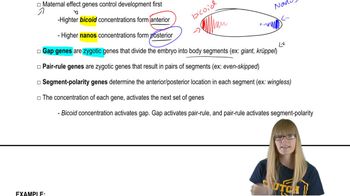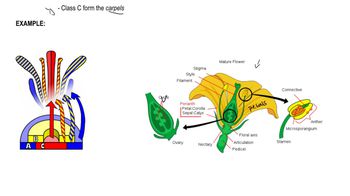Table of contents
- 1. Introduction to Genetics51m
- 2. Mendel's Laws of Inheritance3h 37m
- 3. Extensions to Mendelian Inheritance2h 41m
- 4. Genetic Mapping and Linkage2h 28m
- 5. Genetics of Bacteria and Viruses1h 21m
- 6. Chromosomal Variation1h 48m
- 7. DNA and Chromosome Structure56m
- 8. DNA Replication1h 10m
- 9. Mitosis and Meiosis1h 34m
- 10. Transcription1h 0m
- 11. Translation58m
- 12. Gene Regulation in Prokaryotes1h 19m
- 13. Gene Regulation in Eukaryotes44m
- 14. Genetic Control of Development44m
- 15. Genomes and Genomics1h 50m
- 16. Transposable Elements47m
- 17. Mutation, Repair, and Recombination1h 6m
- 18. Molecular Genetic Tools19m
- 19. Cancer Genetics29m
- 20. Quantitative Genetics1h 26m
- 21. Population Genetics50m
- 22. Evolutionary Genetics29m
14. Genetic Control of Development
Developmental Patterning Genes
Problem 24a
Textbook Question
Homeotic genes are thought to regulate each other. Are similar interactions observed between Hox genes?
 Verified step by step guidance
Verified step by step guidance1
Understand that homeotic genes are a group of genes that control the body plan of an embryo along the head-tail axis. They are crucial in determining the identity of body segments.
Recognize that Hox genes are a subset of homeotic genes found in many animals, including humans. They play a key role in the development of structures along the anterior-posterior axis.
Explore the concept of gene regulation, where genes can influence the expression of other genes. Homeotic genes, including Hox genes, often regulate each other to ensure proper development.
Investigate the interactions between Hox genes. These genes are known to exhibit collinearity, where their order on the chromosome corresponds to their expression pattern along the body axis. This suggests a coordinated regulation.
Consider examples of Hox gene interactions, such as cross-regulation, where one Hox gene can activate or repress the expression of another Hox gene, ensuring the correct patterning of body segments.
Recommended similar problem, with video answer:
 Verified Solution
Verified SolutionThis video solution was recommended by our tutors as helpful for the problem above
Video duration:
1mPlay a video:
Was this helpful?
Key Concepts
Here are the essential concepts you must grasp in order to answer the question correctly.
Homeotic Genes
Homeotic genes are a group of regulatory genes that control the development of anatomical structures in various organisms. They play a crucial role in determining the identity of body segments during embryonic development. Mutations in these genes can lead to significant morphological changes, illustrating their importance in developmental biology.
Recommended video:
Guided course

Segmentation Genes
Hox Genes
Hox genes are a specific subset of homeotic genes that are responsible for the anterior-posterior patterning of an organism's body plan. They are highly conserved across species and dictate the formation of structures such as limbs and organs in specific locations. The interactions and expression patterns of Hox genes are critical for proper developmental processes.
Recommended video:
Guided course

Plant HOX genes
Gene Regulation
Gene regulation refers to the mechanisms that control the expression of genes, determining when and how much of a gene product is made. In the context of homeotic and Hox genes, regulatory interactions can influence the expression of these genes, leading to coordinated developmental processes. Understanding these interactions is essential for grasping how complex body plans are established during development.
Recommended video:
Guided course

Review of Regulation

 11:19m
11:19mWatch next
Master Segmentation Genes with a bite sized video explanation from Kylia Goodner
Start learningRelated Videos
Related Practice

